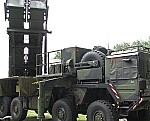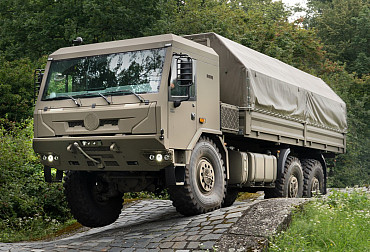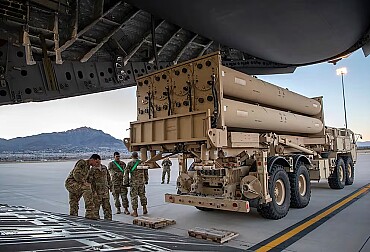Turreted mortars for the British Army – solutions may be provided by Finland, Israel or Poland
British Army representatives have provided information on plans to procure a 120mm calibre turreted mortar system that would be mounted on ARTEC Boxer wheeled armoured personnel carriers. The market offers several possible solutions.
Turreted mortars are cited as a preferable solution not only in the UK. The Czech Army, for example, also defines them as its solution with reference to the requirement of the ability to conduct direct fire. The British plans mark the abandonment of the procurement of a self-propelled mortar of open construction, which, as not only operations in Ukraine show, is a more dangerous solution for the crew than those seated in a closed turret. Because of its design, soldiers operating it are affected by weather factors such as rain, snow or wind, and are much more likely to be injured or killed by small arms fire, or dropped by an incoming quadrocopter. Concerns have also been raised repeatedly about the health of the mortar operators and the noise to which they are exposed.
The British Army currently aims to replace the L16 81 mm mortar, which has been used since the mid-1960s, by a 120 mm mortar. The L16 is fully man-portable with the components divided into loads that can easily be carried dismounted. It has proved to be an extremely reliable system that delivers excellent effect. It has been mounted in the FV432 APC to provide a mobile firepower for infantry battalions, yet with the above mentioned disadvantages.
The selection of the mortar/armoured mortar for the British Army is to be made through a tender process, although the exact parameters that the proposed system must meet have not been specified. The proven Finnish NEMO and the newest Israeli CROSSBOW 120 are among the constructions being considered for the tender, with the former having been deployed in several countries (Sweden, Saudi Arabia, Slovenia and the United Arab Emirates) and having been tried on more than once to the Boxer Wheeled Armoured Vehicle, not only in Germany. As far as the Israeli design is concerned, the problem may be the delayed timetable for completing work on it and the fact that no one has yet officially decided to buy it, although Israel will probably do so as soon as tests are completed. And there is also at least one other proven solution, the Polish RAK.
NEMO from Finland
NEMO (NEw MOrtar) is a turret-based mortar system developed by Finland's Patria as a solution that can be integrated into a wide range of carriers, from wheeled vehicles to naval platforms and even the possibility of integration on a 40-foot container. It can be used to flare targets at a distance of just over 10km. Its semi-automatic loading system allows it to achieve a theoretical rate of fire of 10 shots/min and a practical rate of 6 shots/min when firing continuously. Thanks to its modern fire control system, it can open fire within 25 seconds of detecting a target. The total weight of the system is 1,900 kg, allowing it to be integrated into a wide range of platforms.

NEMO has a digital architecture and C4I networking capability enabling the mortar to rapidly engage targets as well as perform "shoot and scoot" missions. The system can fire at 360° around its own axis and at an elevation range of -3° to 85°, while its ammunition supply is 50–60 mortar grenades. The US Army also wants to rely on the NEMO system, as it now has a prototype version of its tracked armoured multi-purpose vehicle (AMPV) from BAE Systems.
CROSSBOW 120 from Israel
In September 2023, the CROSSBOW 120 system from the Israeli company Elbit Systems on behalf of the Israel Defence Forces was presented at the DSEI trade fair in London. The system is fully automated and is linked to a fire control system that communicates with the battle management system. It is a 120mm calibre turret mortar system which can use a wide range of effectors, from standard 120mm calibre mortar grenades, through those with extended ranges of fire, to laser beam-directed precision mortar ammunition. The base rate of fire is set at 12 shots per minute, which can be temporarily increased to 16 shots per minute. The firing range is 10 km, but will probably be extended with new types of ammunition. The CROSSBOW is expected to be able to fire while underway and to fire at a single target with multiple grenades striking simultaneously (MRSI mode). It can be integrated into multiple platforms like the tracked CV90 or the wheeled Boxer/Eitan.

Concerning the laser beam-directed ammunition: To aim at a target, mortar operators generally use a pointing goniometer. This device is used to orientate, locate and aim the gun at a target. Accuracy varies depending on the equipment used, with rifled-barrelled mortars being more accurate than smooth-bore mortars. However, in order to improve the accuracy of the Cardom range of mortars, the Israeli group Elbit Systems has developed a 120 mm ammunition called the "Iron Sting", which is laser- and GPS-guided.
"Iron Sting provides robust capabilities in all battlefield scenarios with three modes of operation: GPS/IMU, SAL+GPS/IMU and SAL+IMU. The laser and GPS-guided mortar munition has a range of 1-12 km, depending on the mortar tube. Iron Sting features a seeker laser sensor capable of operating with standard pulse (NATO STANAG 3722) and an encoded CW laser diode. The warhead is capable of penetrating double reinforced concrete with a blast and fragmentation effect. Iron Sting features a multi-mode fuze with Point Detonation (PD), Point Detonation Delay (PDD) and proximity sensor (PRX) operating modes," Elbit Systems says.
M120 Rak from Poland
The Polish Rak can boast both deployment in service of more than 120 units and active participation in hostilities in Ukraine. The M120 Rak is a 120mm calibre turret mortar system developed between 2004 and 2015 by the Polish Huta Stalowa Wola (HSW). The turret consists of a shell welded from rolled plates providing level 1 ballistic protection according to the STANAG 4569 standard, in which an armour-piercing mortar loaded using an automatic loading device with a barrel lenght of 25 calibres is embedded. This allows the elimination of targets at a range of 8–12 km (and grenades with a range of 14 km are currently being developed). The firing rate of the system is set at 6–8 grenades per minute, while the ammunition supply is 46 rounds, 20 of which are in the magazine of the reloading machine. For self-defence, the UKM-2000D universal machine gun of 7.62mm calibre is used. The system is equipped with a modern TOPAZ fire control system (by WB Electronics) and an electro-optical sight with a laser rangefinder. The turret drives are electric, but a manual system is available in case of failure. The system is currently used by Poland and Ukraine.

Currently, HSW and WB Electronics have developed a new turret for RAK mortars with twice the rate of fire (now about 15 rounds per minute). The turret uses a new automatic ammunition feeding system combined with a modified barrel design, digital fire control technology and automatically uses information from reconnaissance drones, new navigation systems and digital data transmission. Experience from the deployment of the system in Ukraine has been applied in the development of the new turret.










